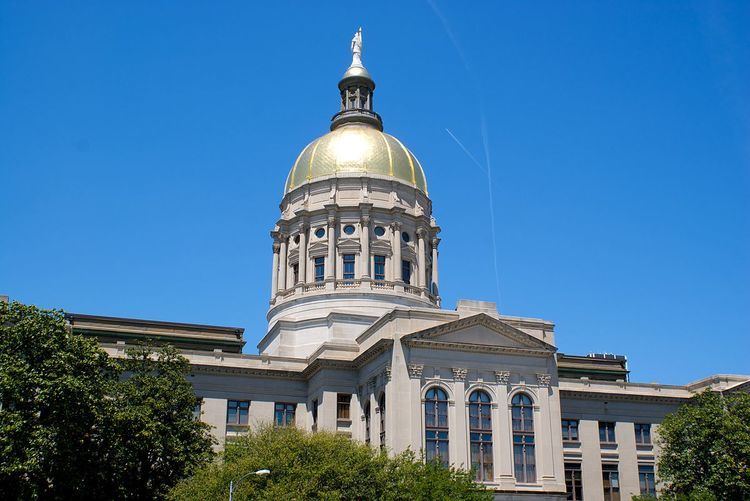Architect Edbrooke and Burnham Added to NRHP December 9, 1971 Area 2 ha | Built 1889 NRHP Reference # 71001099 Opened 1889 Phone +1 404-463-4536 | |
 | ||
Address 206 Washington St SW, Atlanta, GA 30334, USA Hours Closed today SundayClosedMonday8AM–5PMTuesday8AM–5PMWednesday8AM–5PMThursday8AM–5PMFriday8AM–5PMSaturdayClosed Similar Underground Atlanta, Centennial Olympic Park, CNN Center, Oakland Cemetery, Martin Luther King Jr Nation | ||
Walking tour georgia state capitol
The Georgia State Capitol, in Atlanta, Georgia, in the United States, is an architecturally and historically significant building. It has been named a National Historic Landmark and is listed on the National Register of Historic Places. It is the main office building of Georgia's government. The offices of the governor, lieutenant governor, and secretary of state are on the second floor, while the General Assembly meets on the third floor from January to April. The fourth floor houses visitors' galleries overlooking the legislative chambers and a museum.
Contents
- Walking tour georgia state capitol
- Georgia state capitol
- History
- Architecture
- Georgia Capitol Museum
- Dimensions
- Georgias old capitol museum
- References
Georgia state capitol
History
The capitol site was occupied previously by the first Atlanta City Hall. To encourage the state government to relocate the capital city to rapidly growing and industrialized Atlanta from rural Milledgeville, the city donated the site. The first capitol in Louisville no longer stands, while in Augusta and Savannah the legislature met in makeshift facilities, perhaps causing (or caused by) the alternation of those two cities as capital. The legislature also met at other places, including Macon, especially during and just after the Atlanta Campaign of the American Civil War.
Architecture
Like many U.S. state capitols, the Georgia State Capitol is designed to resemble the Classical architectural style of the United States Capitol, in Washington, D.C.. Completed in 1889, the building was designed by architects Willoughby J. Edbrooke and Franklin Pierce Burnham, of Chicago, Illinois. The building was constructed by Miles and Horne, of Toledo, Ohio. Sculptor George Crouch executed all the ornamental work on the building. The commission that oversaw the planning and construction of the building included former Confederate general Philip Cook.
The Capitol faces west on Washington Street. The façade features a four-story portico, with stone pediment, supported by six Corinthian columns set on large stone piers. Georgia's coat of arms, with two figures on each side, is engraved on the pediment. The Capitol's interior represents the 19th-century style of its time. It was among the earliest buildings to have elevators, centralized steam heat, and combination gas and electric lights. Classical pilasters and oak paneling are used throughout the building. The floors of the interior are made of marble from Pickens County, which still produces marble today.
The open central rotunda is flanked by two wings, each with a grand staircase and three-story atrium crowned by clerestory windows. The Capitol building has undergone frequent renovations to adapt to the growth and change of government. Originally constructed from terra cotta and covered with tin, in a 1958 renovation the present dome was gilded with native gold leaf from near Dahlonega in Lumpkin County, where the first American gold rush occurred during the 1830s. For this reason, legislative business is often referred to as what is happening "under the gold dome" by media across the state. The statue Miss Freedom has adorned the dome since the building's opening.
In 1997, the House and Senate chambers were restored to their 1889 appearance with replicated decoration and color schemes. This included the demolition of damaged plaster, the reinstallation of flat plaster at the dome, columns, and walls, and a decorative painting in the House and Senate Chambers.
Georgia Capitol Museum
The museum within the Capitol, in existence since 1889, houses extensive collections representing the natural and cultural history of Georgia. Native American artifacts, animals, rocks and minerals, and fossils illustrate the diversity of the collections. During restoration or renovation, most of the collection remains in storage. The portraits of governors, statues of famous Georgians, and historic flags from many wars are displayed throughout the Capitol.
The Georgia Capitol Museum is a public education institution in the Office of the Secretary of State. The museum seeks to preserve and interpret the history of the Georgia Capitol in Atlanta, the functions of the government, and the events that have occurred in the Capitol. To accomplish this, the museum collects, preserves, and interprets artifacts relating to the Capitol or associated with the events that have occurred there.
Dimensions
Georgia's old capitol museum
Georgia's second capitol building is at 201 East Greene Street, Milledgeville, Georgia, and served as state capitol until 1867. The building was severely damaged by a fire March 24, 1941 and was rebuilt in its former design to serve as a part of Georgia Military College. The first floor of the old capitol is open as a museum.
